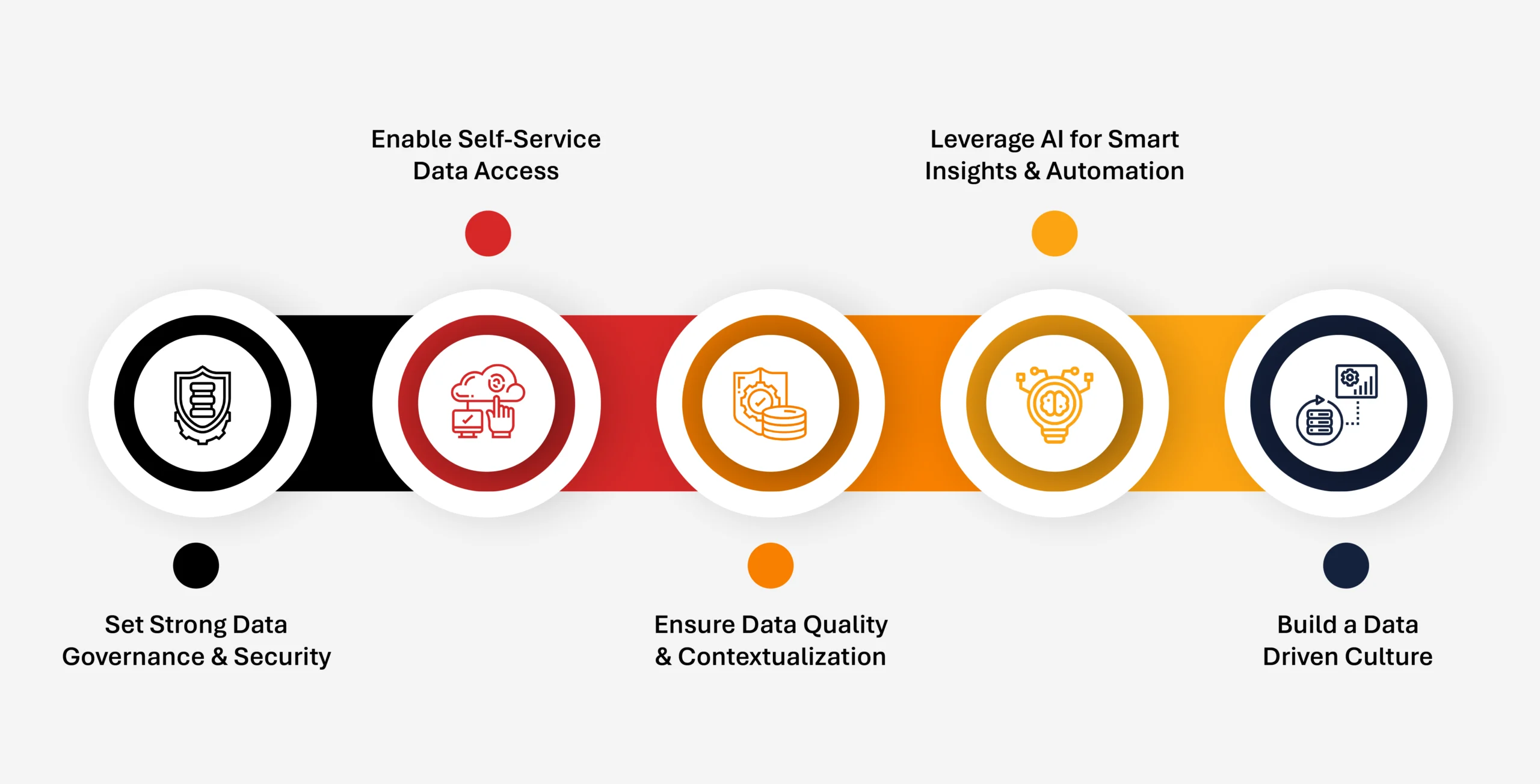Data democratization is the process of making data accessible to all stakeholders within an organization, regardless of their technical expertise. It involves breaking down data silos and providing tools, education, and governance frameworks that empower employees to access, understand, and utilize data in their decision-making processes. This approach fosters a data-driven culture, enabling more informed decisions across all levels of the organization and driving innovation and efficiency.
Empowering Data Ownership: Strategic Approaches to Data Democratization in Modern Enterprises


Imagine working in a company where every decision—big or small—relies on data, yet only a handful of people have access to it. It’s like trying to drive in the dark without headlights. Frustrating, right?
For years, data has been confined to silos, and its power is only in the hands of a few. Today’s fast-paced business environment, though, where agility and insight decide success, makes it impossible for such an outdated model. Data democratization is not about making data available; it’s about providing access to the right people at the right time while ensuring security and compliance are maintained.
It is the moment an organization with data democratization transforms data from an isolated resource to become a strategic asset as it empowers employees to make rapid, smart, and informed decisions. However, the shift isn’t as simple as opening the floodgates. Democratization can easily turn into chaos instead of becoming a competitive advantage when not done with the right governance, security, and tools.
So how do businesses catch the perfect balance between access, control, and security? Let’s break it down.
- Set Strong Data Governance & Security
Data democratization sounds fantastic until you see how fast things can spin out of control if proper governance is lacking. You cannot hand out access to sensitive data without hope and anticipation of getting burned. Organizations have to begin from a very solid foundation in terms of governance and security. That comes with defining ownership, access rights, and what should happen and not happen. Role-based access controls (RBAC) makes sure that the right persons are allowed to have the right permissions, while data sovereignty policies help businesses maintain compliance with such laws as GDPR and DPDP Act. But this security is not just about erecting rules; it is about constant vigilance. A zero-trust model means verifying every user and device before granting access, and Data Security Posture Management (DSPM) tools provide real-time monitoring to spot vulnerabilities before they become full-blown breaches. Done right, governance doesn’t slow things down—it enables secure and responsible data democratization.
- Enable Self-Service Data Access
Imagine needing critical business data and waiting days—or even weeks—for IT to pull it from some buried database. Frustrating, right? That’s precisely the type of bottleneck self-service data access eliminates. Businesses embracing data democratization empower employees with AI-powered catalogs and metadata management software, making data easy to find, understand, and use. Instead of IT teams acting as gatekeepers, business users can search, retrieve, and analyze the data they need on their own—without uncalled-for delays. But let’s be clear: self-service data management doesn’t mean free-for-all. Guardrails prevent unauthorized access and misuse. Open access balanced with strong governance ensures that democratization works in favor of the business and does not create new risks.
- Ensure Data Quality & Contextualization
Accessing data is one thing, but usability is another. Just imagine making a decision based on old or incorrect data. The results can be catastrophic. That is why data democratization needs to go hand in hand with data quality and contextualization. AI-driven classification and cleansing tools help by automatically tagging, organizing, and filtering out irrelevant or duplicate data so that users aren’t drowning in noise. But data isn’t just about numbers and text; it needs context. Data lineage tracking helps businesses understand where their data comes from, how it’s been transformed, and who has used it. This transparency builds trust, ensuring that when employees access data, they’re working with reliable, high-quality information—not just a messy pile of numbers.
- Leverage AI for Smart Insights & Automation
We’re generating more data than ever, and let’s face it—no human team can manually process and analyze it all efficiently. That’s where AI steps in. AI-powered analytics unlock valuable insights from massive volumes of unstructured data, making it easier to spot patterns, identify anomalies, and drive informed decision-making. Predictive modeling allows businesses to stay ahead of trends, while machine learning algorithms help automate everything from data tagging to governance enforcement. Instead of hours spent sifting through datasets, AI enables teams to focus on what matters: applying insights to real-world challenges. In the world of data democratization, AI isn’t an added value but rather a must.
- Build a Data-Driven Culture
Even the best data strategies will fall flat if the company culture doesn’t support them. Data democratization is not just a shift in technology but also a mindset. Employees need to be empowered to use data, and that begins by building data literacy across the organization. Training programs, hands-on learning, and leadership support can make data a language everyone speaks, not just data scientists. When IT, business teams, and leadership collaborate around data instead of working in silos, the entire organization benefits. More than just providing access, fostering a data-driven culture ensures that data is used effectively, responsibly, and strategically.
With governance, AI-driven intelligence, self-service capabilities, and a culture of trust, businesses can turn data from a locked-down asset into a catalyst for growth, innovation, and smarter decision-making. Data democratization isn’t just the future—it’s the present, and companies that get it right will lead the way.
Industry Insights and Trends
- By 2026, the amount of data globally is projected to be 221 zettabytes, most of which will be unstructured and thus more susceptible to being misused.
- 80-90% of this data will be unstructured, and thus it will require sophisticated self-service data management software to access insights.
- 60% of organizations have lost data due to an exploited vulnerability.
Getting Started with Data Dynamics:
- Learn about Unstructured Data Management
- Schedule a demo with our team
- Read the latest blog: The Chief Information Security Officer’s Playbook for 2025: Trust, Innovation, and Resilience






